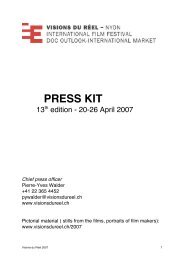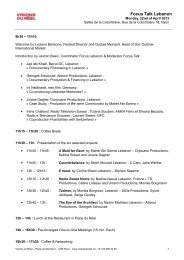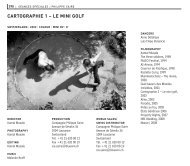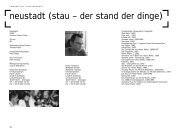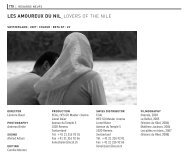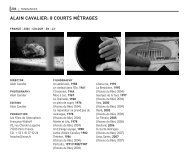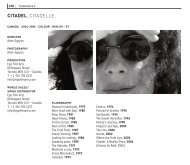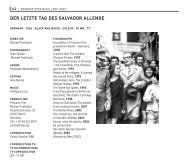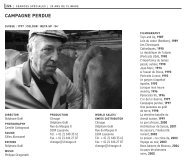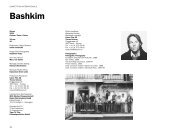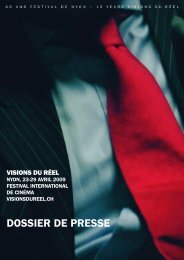Katalog 2013.pdf - Visions du Réel
Katalog 2013.pdf - Visions du Réel
Katalog 2013.pdf - Visions du Réel
You also want an ePaper? Increase the reach of your titles
YUMPU automatically turns print PDFs into web optimized ePapers that Google loves.
150 premiers pas<br />
Soe Moe Aung<br />
Insein<br />
Rhythm<br />
Germany, Myanmar | 2013 | 11’ | HD | No Dialogue<br />
World Premiere<br />
Cinematography<br />
Han Lin Thwin<br />
Sound<br />
Nu Nu Hlaing<br />
Editing<br />
Kyaw Myo Lwin<br />
Pro<strong>du</strong>ction<br />
Lindsey Merrison<br />
(Yangon Film School)<br />
Filmography<br />
2013 Insein Rhythm (sf)<br />
2012 The Painter (sf)<br />
2011 Behind the Mask (sf)<br />
Contact<br />
Johanna Huth<br />
+49 3095614327<br />
huth@yangonfilmschool.org<br />
yangonfilmschool.org<br />
La gare d’Insein est l’un des arrêts <strong>du</strong><br />
train circulaire de Yangon, en Myanmar.<br />
Elle se trouve non loin de la tristement<br />
célèbre prison d’Insein. Ce premier film<br />
<strong>du</strong> réalisateur Aung Soe Moe réussit<br />
le portrait délicat de la vie quotidienne<br />
aux alentours de la gare. Les différentes<br />
ambiances <strong>du</strong> lieu s’y entremêlent<br />
comme dans un morceau de musique<br />
minimaliste. A première vue, les diverses<br />
scènes semblent complètement décousues,<br />
mais au fur et à mesure que le<br />
train se rapproche, il devient évident<br />
qu’elles forment un motif rythmique harmonieux.<br />
Cette structure narrative et ce<br />
mécanisme d’observation permettent au<br />
réalisateur de dépeindre les espoirs d’un<br />
pays qui lutte pour un lendemain meilleur.<br />
Comme issu de l’âge <strong>du</strong> cinéma<br />
muet, Insein Rhythm parvient à prendre<br />
une position politique claire par le jeu de<br />
sa construction « busterkeatonienne ».<br />
La gare, tout comme la prison (que l’on<br />
ne voit pas), sont la métaphore d’une<br />
contradiction : mouvement et immobilité.<br />
La composition rythmique <strong>du</strong> film tra<strong>du</strong>it<br />
ainsi le secret espoir en un mouvement<br />
collectif apte à apporter de profonds<br />
changements dans la société birmane.<br />
Der Bahnhof Insein liegt an der Yangon<br />
Ringbahnlinie in Myanmar. Nicht weit<br />
entfernt von dem berüchtigten Gefängnis<br />
Insein. Der Regisseur Aung Soe<br />
Moe schafft mit seinem ersten Werk<br />
ein gewissenhaft strukturiertes Porträt<br />
der alltäglichen Aktivitäten am Bahnhof.<br />
Wie in einem kurzen, minimalistischen<br />
Musikstück verwebt er die verschiedenen<br />
Rhythmen des Ortes miteinander.<br />
Auf den ersten Blick wirkt es, als<br />
bestünde kein Zusammenhang zwischen<br />
den unterschiedlichen Gesten.<br />
Mit dem näher kommenden Zug wird<br />
jedoch deutlich, dass sich alles zu einem<br />
harmonischen rhythmischen Muster<br />
zusammenfügt. Mittels dieser narrativen<br />
und beobachtenden Struktur zeichnet<br />
der Regisseur die Hoffnungen eines<br />
Landes nach, das um bessere Zukunftsperspektiven<br />
ringt. Gleich einem Werk<br />
aus der Stummfilmzeit gelingt mittels<br />
der Buster Keaton-esquen Struktur<br />
von Insein Rhythm eine klare politische<br />
Aussage. Der Bahnhof und das (nicht<br />
gezeigte) Gefängnis dienen als Metapher<br />
eines Gegensatzes: Bewegung<br />
und Stille. Das rhythmische Muster wird<br />
somit zur unausgesprochenen Hoffnung<br />
für eine gemeinschaftliche Arbeit, die zu<br />
Veränderungen in der myanmarischen<br />
Gesellschaft führen wird.<br />
Insein Railway Station lies on the Yangon<br />
Circular Railway, in Myanmar. It is not far<br />
from the infamous Insein prison. Firsttime<br />
director Aung Soe Moe composes<br />
a carefully crafted portrait of the daily<br />
activities that surround the railway station.<br />
Like in a small minimalistic musical<br />
piece, he weaves the distinctive rhythms<br />
of the place together. At first glance, it<br />
looks like the different gestures are disjointed<br />
from each other. But as the train<br />
gets closer and closer it becomes clear<br />
that it all builds up to a harmonic rhythm<br />
pattern. Through this kind of narrative<br />
and observational structure, the director<br />
manages to portray the hopes of a country<br />
that is struggling to achieve a better<br />
tomorrow. Like a work from the silent<br />
era of film, Insein Rhythm manages to<br />
make a deeply articulate political statement<br />
through its BusterKeaton-esque<br />
structure. The station and the (unseen)<br />
prison are the metaphor of a contradiction:<br />
movement and stillness. The rhythmic<br />
pattern thus becomes the unspoken<br />
hope for a collective work that is bound<br />
to provoke changes in Burmese society.<br />
Giona A. Nazzaro



